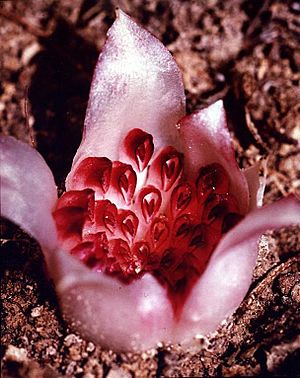Western underground orchid facts for kids
Quick facts for kids Western underground orchid |
|
|---|---|
 |
|
| Rhizanthella gardneri | |
| Conservation status | |
| Scientific classification | |
| Genus: |
Rhizanthella
|
| Species: |
gardneri
|
The western underground orchid (Rhizanthella gardneri) is a very special plant. It's an orchid that lives its whole life underground! You won't see it growing tall like other plants. This amazing orchid is only found in the southwest of Western Australia.
It grows a head of up to 100 small flowers. These flowers are reddish to cream-coloured and face inwards. They are surrounded by large, cream-coloured leaves called bracts. This happens between May and July.
Contents
What the Western Underground Orchid Looks Like
Rhizanthella gardneri is a plant without leaves. It has a horizontal stem, called a rhizome, that grows about 6 to 12 centimeters (2.4 to 4.7 inches) below the ground.
From late May to early June, the plant produces up to 100 small flowers. These flowers are about 4 to 5 millimeters (0.16 to 0.20 inches) wide. They can be pinkish, deep red, or cream-coloured and face inwards.
The flowers are surrounded by 6 to 12 pinkish-cream bracts. These bracts curve over the flowers, making a shape like a tulip. They leave a small opening at or just above the soil surface.
After the flowers are pollinated, each one makes a soft, berry-like fruit. This fruit can hold up to 150 seeds. Unlike most orchids that have tiny, dust-like seeds carried by the wind, this orchid's fruit does not open to release its seeds.
How This Orchid Was Found
The first Rhizanthella gardneri was found by John Trott in May 1928. He was ploughing his farm near Corrigin when he discovered it. People were so excited about this discovery that a wax model of the orchid was shown around the British Isles!
More specimens were found in similar ways until 1959. Then, in 1979, John McGuiness saw plants growing in their natural home near Munglinup. In the early 1980s, over 100 flowering plants were found in the Munglinup area. However, these plants are now considered a different species called Rhizanthella johnstonii.
The Western underground orchid was officially named in 1928 by Richard Sanders Rogers. The name gardneri honors Charles Gardner, who was an assistant botanist in Western Australia at the time.
Where the Orchid Lives
Rhizanthella gardneri is only found in a specific area of Western Australia called the Avon Wheatbelt. It grows with a plant called broom honeymyrtle (Melaleuca uncinata). You can find it between Corrigin and Babakin.
The Orchid's Life Cycle and How It Gets Food
This orchid spends its whole life underground, even when it flowers. It gets its energy and food in a very special way. It's a myco-heterotroph, which means it gets nutrients from fungi.
These fungi connect with the roots of broom honeymyrtle plants, like M. uncinata. The orchid then gets food from the fungi, which got it from the broom honeymyrtle. It's like a hidden food chain underground! The fungus involved is thought to be Thanatephorus gardneri.
Even though the flowers are underground, their heads crack open the soil as they get older. Sometimes, the tips of the bracts poke through the leaf litter. This leaves a small opening for insects to enter. Termites and ants have been seen going into the flower heads.
The orchid's seeds are too big for the wind to carry them. It's possible that small animals eat the juicy fruit and then spread the seeds when they go to the bathroom.
Protecting This Special Orchid
The Western underground orchid is listed as "critically endangered" by the Australian Government. This means it's in great danger of disappearing forever. It's also listed as "Threatened Flora" by the Department of Environment and Conservation in Western Australia.
Much of the Wheatbelt area where this orchid lives has been cleared for farming. This has led to a loss of its home, the broombush habitat. Drought and increasing salt in the soil also threaten the orchid.
Good news! Three of the known groups of Rhizanthella gardneri are protected in nature reserves. People are working hard to save this species for the future. Groups like the Millennium Seed Bank at Royal Botanic Gardens, Kew, Australia's Endangered Species Program, and Perth's Kings Park and Botanic Gardens are all working together. They are studying the orchid's DNA and storing its seeds. Their goal is to start a program to grow more of these rare orchids.
Images for kids



